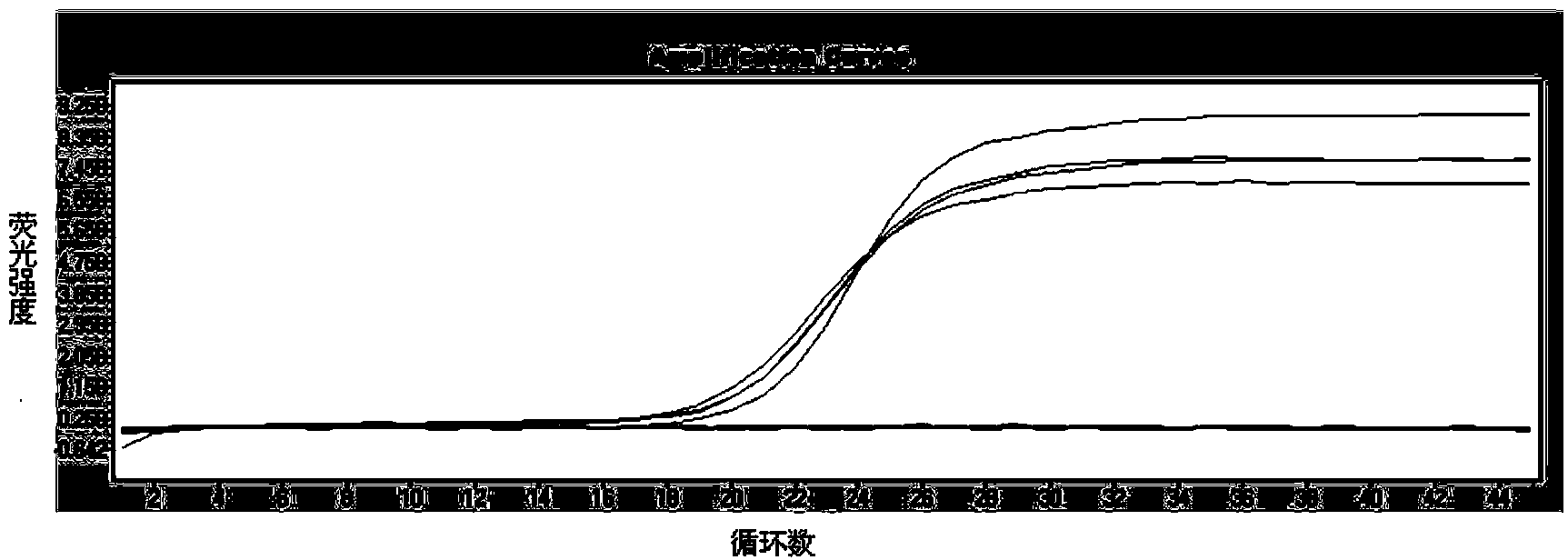Kit for detecting coronavirus through real-time fluorescent RT-PCR (Reverse Transcription-Polymerase Chain Reaction) and application thereof
A technology of RT-PCR and detection kits, which is applied in the field of real-time fluorescent RT-PCR detection kits for coronaviruses, can solve the problems of application limitations, lack of cross-reactive antigens, etc., and achieve high specificity and high sensitivity.
- Summary
- Abstract
- Description
- Claims
- Application Information
AI Technical Summary
Problems solved by technology
Method used
Image
Examples
Embodiment 1
[0035] Example 1: Development of coronavirus one-step real-time fluorescent quantitative PCR reagent
[0036] 1. The design of primers and probes: by using the DNAman software to carry out sequence comparison analysis on the existing coronavirus nucleic acid sequences in the Genebank database, the conserved fragments of the human coronavirus genome are used as the amplification target site, and the primers and probes are designed The basic principle is to use software to manually design multiple pairs of primers and probes.
[0037] 2. Selection of samples: According to relevant domestic and foreign literature reports, samples such as sputum and nasopharyngeal swabs can be selected.
[0038] 3. Establishment and optimization of the reaction system
[0039] Preparation of samples: 10 samples identified as coronavirus-positive by the virus were used as CoV-positive reference materials, respectively CoV-1, CoV-2, CoV-3, CoV-4, CoV-5, CoV-6, CoV-7 , CoV-8, CoV-9, CoV-10; 10 non-...
Embodiment 2
[0048] Embodiment 2: Human coronavirus one-step fluorescent real-time quantitative RT-PCR detection kit and its use
[0049] 1. Prepare a kit including the following components: RNA extraction solution, RT-PCR amplification reaction solution, negative quality control substance, positive quality control substance, quantitative reference substance, and DEPC-treated water.
[0050] 2. Collection, transportation and storage of specimens
[0051] 2.1 Applicable specimen types: sputum, nasopharyngeal swab, etc.
[0052] 2.2 Specimen collection and pretreatment (pay attention to aseptic operation)
[0053] 2.2.1 Sputum sample collection: Morning sputum is better. Before collecting samples, you should rinse your mouth with clean water or cold boiled water or use a toothbrush (without toothpaste) to clean your mouth and teeth. If you have dentures, you should remove them (in order to reduce the normal oral flora Contaminated specimens), forcefully cough up the sputum in the deep part...
Embodiment 3
[0070] Example 3: Clinical detection of coronavirus one-step fluorescent real-time quantitative RT-PCR detection kit
[0071] The above method was used to detect 18 sputum specimens of patients with suspected coronavirus infection, of which 4 cases were positive for CoV detection, and the virus fluorescence quantitative PCR amplification curve is shown in image 3 , according to the C of these 4 positive results t Value combined with the amplification curve, the Roche LightCycler480 analysis software automatically analyzed the virus concentration of these 4 cases of CoV positive samples, the specific results are shown in Table 1.
[0072] Table 14 Cases of CoV positive specimen virus concentration
[0073] Sample serial number
Ct value
CoV virus concentration (copy number / μl)
sample 1
21.34
2.35×10 2
sample 2
20.98
2.92×10 2
sample 3
22.46
2.48×10 3
Sample 4
21.68
3.48×10 2
[0074]
[00...
PUM
 Login to View More
Login to View More Abstract
Description
Claims
Application Information
 Login to View More
Login to View More - R&D
- Intellectual Property
- Life Sciences
- Materials
- Tech Scout
- Unparalleled Data Quality
- Higher Quality Content
- 60% Fewer Hallucinations
Browse by: Latest US Patents, China's latest patents, Technical Efficacy Thesaurus, Application Domain, Technology Topic, Popular Technical Reports.
© 2025 PatSnap. All rights reserved.Legal|Privacy policy|Modern Slavery Act Transparency Statement|Sitemap|About US| Contact US: help@patsnap.com



